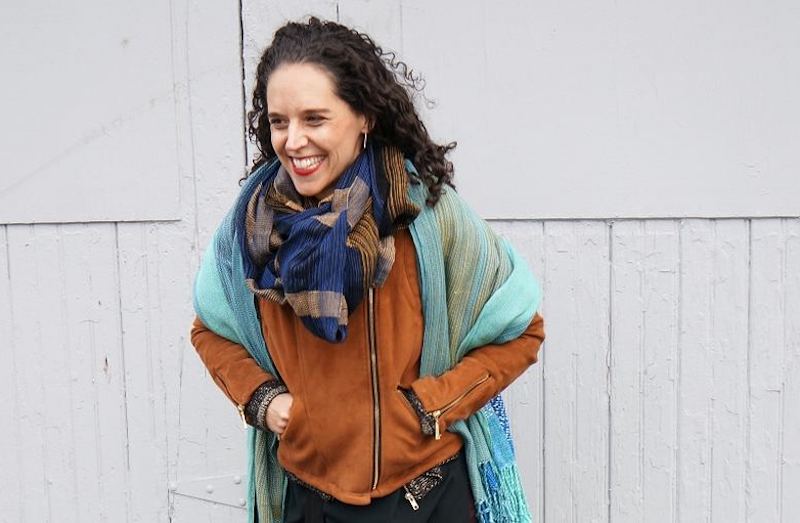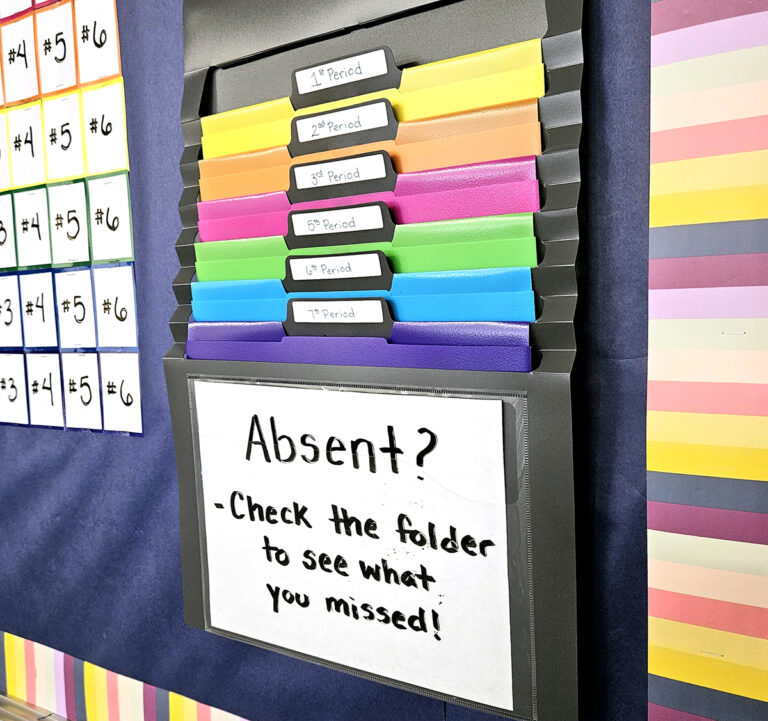Do you remember your very first day of teaching? How you felt when students started walking into your classroom, and you realized you were alone and in charge?
I do.
Many of my students were inches taller than me, requiring me to look up to them. Others appeared much older than they were. For a moment, I was terrified. Surely someone made a mistake putting me in charge of a room full of teenagers.
Do you feel unsure of what to do when it comes to managing your classroom?
Building relationships is the foundation of classroom management. When high school students form a connection with you, they’ll be your greatest allies. On the flip side, if they feel you are unfair or unwilling to listen, no management techniques will save you.
As you develop your classroom management plan, pick and choose ideas that align with your personality and style of teaching. Give yourself time to experiment and reflect knowing what works for one group, may not work for another.
Here are five essential tips for managing your high school students.

1. The first day matters.
First impressions have a lasting impact, so choose carefully. Most classes take the first day to review the syllabus. Put yourself in your students’ shoes. Imagine going from room to room, listening to an endless drone of rules. This model sets students up for failure, as boredom takes over and behavior problems arise.
Skip the syllabus!
Instead, do activities that set the tone for your class. Through these activities, demonstrate your rules and expectations. Students will learn more, and you’ll be less likely to have to deal with discipline issues on day one.
When planning your first day ask yourself the following questions:
- What are the most important things for students to understand about the art room?
- How do I want students to behave, and how can I reflect that in an activity?
- In what ways can/will I interact with students on day one?
Here’s a paper airplane example from my high school sculpture class.

On the first day of my high school sculpture class, we make paper airplanes. You’re likely thinking this sounds great in theory, but in practice must be total chaos. Stick with me.
If you’d like to try this in your classroom, here’s what to do:
- Start by breaking students into groups of four or five.
- Provide them with two pieces of 11 x 14 paper and four index cards.
- Using the supplies provided, have students work together to design and create two paper planes. One plane should be as large as possible, the other as small as possible. The goal is to get the planes to fly as far as possible. Allow thirty minutes of work time.
- As the timer rings, head into the hallway (the runway). The paper plane competition is on.
There is laughter, applause, and questions about how one group made such a great plane. THIS is what I want my room to look like every day.
With a dynamic activity like this, it’s important to have a game plan. During the design and testing phase, you’ll want to continue moving around the room. Ask students questions about their design and encourage them to push their ideas further.
It’s also helpful to assign specific roles to students within each group. Here are some roles:
- Pilot
The pilot is in charge of flying all planes. They will do all test flights as well as the final flight. The pilot must be sure to avoid crashing into people or knocking things over while flying. - Engineer
The engineer is the main person in charge of folding the planes and making adjustments as needed. They may have assistance from team members upon request. - Researcher
The researcher is in charge of finding helpful tutorials, providing construction ideas, and troubleshooting when a test flight doesn’t go well. - Project Manager
The project manager determines a plan of action, defining what needs to be done and by whom. The project manager helps to ensure that the team is moving forward and using their time wisely.
Once in the hallway, follow a clear takeoff schedule. One plane flies at a time, its landing location marked with a post-it. You might also invite administrators or others in your building to view the competition. This serves two purposes; others in your building get to see the creative process in action, and you have more adults to help monitor your students.
How do you want your first day to look?
Instead of reading about rules and expectations, let students experience them. Have them work together, demonstrate respect, ask questions, try, fail, and try again. Allow them to celebrate others’ success and share in their failure. They will learn from each other.
Be bold.
On that first day, we end class with a questionnaire, demonstrating that we’ll end most classes with reflection. The question asks, “If you could ask Mrs. Kane anything, what would it be?” (You may feel this is a risky question. It is. That’s the point. But, in eleven years I’ve never had an issue.)

Don’t promise to answer the questions. Students tend to assume you’re not going to. Surprise them by answering each to the best of your ability. Doing so will show them you are honest, which in turn will earn you respect and help build connections.
Storytelling is another powerful way to show your honesty and build connections with your students. That’s why in AOEU’s Managing the Art Room course, students have an assignment where they compose a story to tell their students that fit in with their curriculum or classroom management outcomes. Letting students get to know you have so many positive implications for your classroom!
The bell rings.
How do you want students to exit your room? Most teachers hold the philosophy that they, not the bell, dismiss the class. This expectation needs to be established and demonstrated.
My classes always end with a question on the board. Students write a short response, no more than two sentences, and hand me the paper as they walk out the door. Since it’s the first day, about ten minutes before the end of class, take the time to point out the question on the board, and explain the process to your students. Make the question simple. It will allow all students to feel confident they will succeed. I usually ask something like, “What are you most looking forward to today at school or home?”
You’ve demonstrated your rules and expectations, piqued students’ curiosity, and made connections.
2. Use exit tickets to connect.

Exit tickets are a great tool to review and check for understanding, but they can also be a powerful tool for connecting. Large class sizes make it a challenge to talk to all of your students. Exit tickets are a way to show your interest while also providing students a format for sharing.
Here are some sample exit ticket questions:
Questions that make students think.
- How would your life be different if you had two thumbs on each hand?
- You don’t know what you don’t know, so what don’t you know?
- Using only black and white, how would you represent the color red?
Questions that create a space to share.
- Describe your ideal Saturday.
- What are you the most excited about this week?
- What are you the most afraid of?
3. Don’t skip the small stuff.
One day, students started describing the different pants I wore to work. They accurately recounted every pair I owned. In another instance, students began reading my engagement announcement (they were Googling me). Students pay close attention as they search to make connections.
In the book Bounce: Mozart, Federer, Picasso, Beckham, and the Science of Success by Matthew Syed, psychologist Greg Walton, and Geoffrey Cohen reveal a study showing students who can find similarities to their teacher perform better than those who see no commonalities.
It can be something as simple as a shared birthday, liking the same music, or having the same taste in shoes. This means you need to provide information and create opportunities for your students to see themselves in you.

Consider having a few personal photos on your desk, telling students about your favorite movie, book, band, or sports team. Listen to your students, ask them questions, and point out things that you have in common. You might say, “My birthday is in April, too!”
If you’re having trouble finding something in common with a student, allow them to teach you. Let them show you how to use a new app, listen to their favorite song, show up at their sporting event, or try out their favorite nail polish color.
4. Learn students’ names.
It can be hard when you see hundreds of students and you need to learn their names. But knowing students’ names is essential to effective classroom management. Consider drawing sketches, taking photos, or even having students record short videos. Put practices in place that allow you to learn students’ names while also ensuring you’re saying them correctly. Make it a goal to say every student’s name at least once throughout every class. This helps you remember their names and helps them to feel seen.
Instead of using the class roster provided by guidance, I create my own form that allows room for notes and sketches.
It includes a box for me to record nicknames and space for me to write out the phonetic version of a student’s name. I make notes about distinguishing qualities, like glasses, hair color, or piercings. While students fill out the first-day questionnaire, I take the time to write further notes or make sketches. Over the next few class periods, I keep the form with me, forcing myself to call students by name, and rehearsing whenever possible.

5. Keep your end goal in mind.
No matter who you are or what you do, you’re going to run into students who challenge you. When working with challenging students, you will likely need to compromise. When doing so, ask yourself, “What is the end goal?”
Once you’re clear on the end goal, figure out what things are essential as well as some areas for compromise. For example, if a student balks at an assignment, can you make adjustments to the prompt or constraints and still arrive at the same end goal? Being clear about when and how you will and will not compromise allows you to have honest and consistent conversations with your students.
Overall, when it comes to classroom management, focus on building relationships with your students from day one. High school students are seeking autonomy, trust, and connection. Help them to find those things in your art room!
What is one strategy from above you will implement this week?
Think of a student with whom you’re currently struggling, what is one thing the two of you have in common?
Magazine articles and podcasts are opinions of professional education contributors and do not necessarily represent the position of the Art of Education University (AOEU) or its academic offerings. Contributors use terms in the way they are most often talked about in the scope of their educational experiences.





